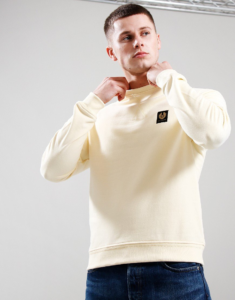Fashion has always been an evolving canvas, reflecting societal shifts, technological innovations, and individual aspirations. As we navigate the complexities of the modern world, fashion is adapting in exciting ways, with new trends paving the way for a future that is sustainable, inclusive, and digitally driven. Here’s a look at the trends shaping tomorrow’s style.
Sustainability as a Standard
Sustainability is no longer a niche concern; it has become a fundamental principle driving the fashion industry. Human Made Consumers are increasingly aware of the environmental impact of their choices and are seeking brands that align with their values.
This shift has led to the rise of circular fashion, which emphasizes reuse, recycling, and reducing waste. Clothing rental platforms like Rent the Runway and subscription services such as Nuuly are thriving, offering consumers access to high-quality garments without the commitment of ownership. This not only reduces waste but also encourages the idea of shared wardrobes.
Innovative materials are also making a splash. Fabrics like Piñatex (made from pineapple leaf fibers) and lab-grown leather offer sustainable alternatives to traditional textiles. Brands are embracing these options to create eco-friendly collections, demonstrating that luxury and responsibility can coexist.
Moreover, transparency is becoming a key trend. Consumers want to know where their clothes come from and how they are made. Brands that provide detailed insights into their supply chains, such as Patagonia and Everlane, are setting a standard for accountability in fashion.
Digital Fashion: Dressing in the Virtual Realm
The rise of digital fashion is redefining what it means to “wear” something. In the virtual realm, clothing designed for avatars and social media presence is gaining traction, offering new opportunities for creativity and sustainability.
Brands like The Fabricant and DressX are pioneering this movement, creating digital garments that exist solely online. These designs allow users to dress their avatars or enhance their social media presence without contributing to the environmental impact of physical production.
Gaming and the metaverse are significant drivers of this trend. Platforms like Roblox and Fortnite have partnered with major fashion brands to release exclusive virtual collections, blurring the lines between fashion and entertainment. Gucci, for instance, sold a digital version of its Dionysus bag on Roblox for more than its physical counterpart.
Digital fashion also opens the door to hyper-personalization. Advanced 3D modeling software allows consumers to commission bespoke virtual outfits, tailoring their digital identity to their exact preferences.
Tech-Enhanced Garments
Fashion is becoming smarter, integrating technology into everyday wear to enhance functionality and user experience. Smart textiles and wearable technology are at the forefront of this revolution.
Garments with embedded sensors are transforming how we think about clothing. Fitness wear, for example, now includes items like Nadi X yoga pants, which provide haptic feedback to guide wearers into proper poses. Similarly, jackets with built-in heating systems, like those from Ororo, are combining style with practicality.
Smart textiles are also addressing health and safety concerns. Clothing that monitors vital signs, detects pollutants, or adjusts to temperature changes is becoming increasingly common. This blend of fashion and utility showcases how technology can make our lives more comfortable and efficient.
Inclusivity and Representation
Modern fashion is moving away from rigid standards to embrace diversity and inclusivity. Consumers are demanding representation that reflects the real world, pushing brands to cater to a broader range of identities, sizes, and cultural narratives.
Gender-neutral fashion has gained significant traction, with brands like Gucci and Telfar creating collections that transcend traditional gender categories. These designs promote self-expression, allowing individuals to define their style without societal constraints.
The body positivity movement is also influencing fashion. Inclusive brands like Savage X Fenty and Universal Standard are offering extended size ranges and showcasing diverse models in their campaigns. This shift empowers people of all shapes, sizes, and backgrounds to feel confident in their clothing.
Cultural appreciation is another growing trend. Designers are increasingly collaborating with artisans and communities to showcase traditional craftsmanship. By honoring and celebrating diverse cultural influences, fashion is fostering a global sense of connection and creativity.
Sustainable Luxury
The luxury sector, traditionally seen as indulgent, is embracing sustainability in innovative ways. High-end brands are incorporating eco-friendly practices while maintaining their commitment to quality and exclusivity.
Chanel’s launch of its first sustainable beauty line and Hermès’ experimentation with lab-grown leather highlight how luxury and environmental consciousness can coexist. The rise of second-hand luxury markets, like The RealReal, is also reshaping consumer attitudes, making pre-loved items a chic and responsible choice.
Fashion as Activism
In the modern world, fashion has become a platform for activism. Slogan tees, protest art, and bold statements on garments are being used to raise awareness about social, political, and environmental issues.
Designers like Vivienne Westwood and Stella McCartney have long championed causes through their work, and today’s consumers are joining in by wearing clothing that reflects their values. Fashion, in this sense, becomes a tool for advocacy and change, empowering individuals to voice their beliefs through style.
The Future of Fashion
As we look ahead, the future of fashion is one of innovation and transformation. Sustainability will remain at the forefront, driven by both consumer demand and technological advancements. Digital fashion and wearable technology will continue to redefine our relationship with clothing, blurring the boundaries between the physical and virtual worlds.
Fashion is more than just an industry—it is a reflection of our times and an expression of who we are. By embracing change and pushing boundaries, the future of fashion promises to be as diverse, innovative, and forward-thinking as the people it serves.






